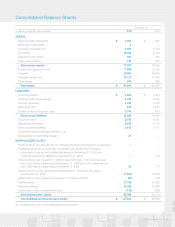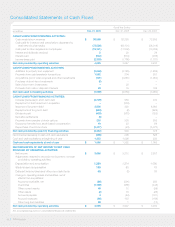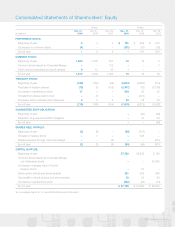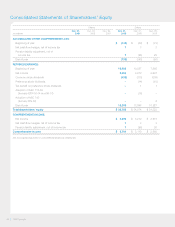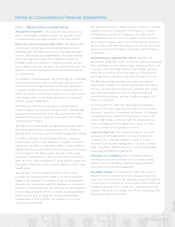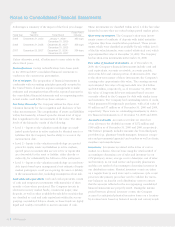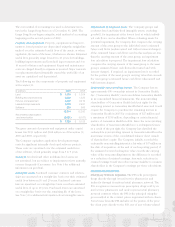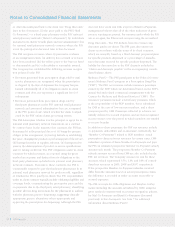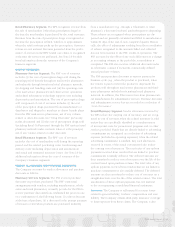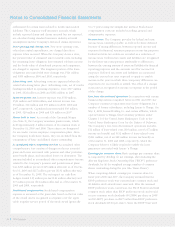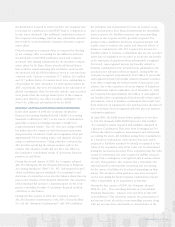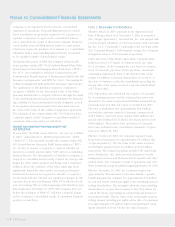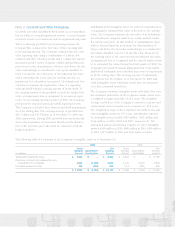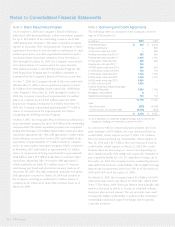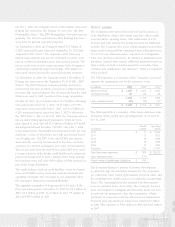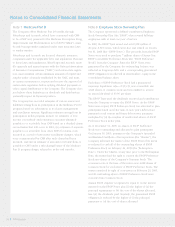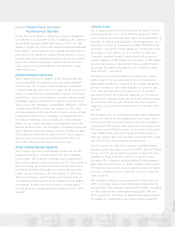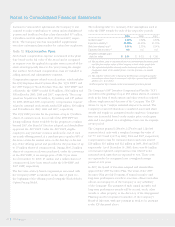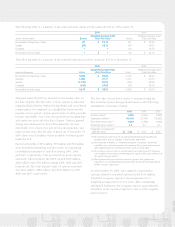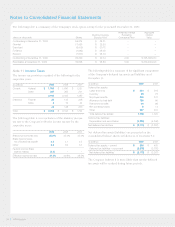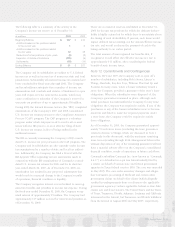CVS 2009 Annual Report Download - page 59
Download and view the complete annual report
Please find page 59 of the 2009 CVS annual report below. You can navigate through the pages in the report by either clicking on the pages listed below, or by using the keyword search tool below to find specific information within the annual report.
the principles and requirements for how an acquirer recog-
nizes and measures in its financial statements the identifiable
assets acquired, the liabilities assumed, any noncontrolling
interest in the acquiree and the goodwill acquired. The
guidance also establishes disclosure requirements that will
enable users to evaluate the nature and financial effects of
business combinations. ASC 805 requires that income tax
benefits related to business combinations that are not recorded
at the date of acquisition are recorded as an income tax benefit
in the statement of operations when subsequently recognized.
Previously, unrecognized income tax benefits related to
business combinations were recorded as an adjustment to the
purchase price allocation when recognized. During 2009, the
Company recognized approximately $147 million of previously
unrecognized income tax benefits related to business combina-
tions (after considering the federal benefit of state taxes), plus
interest, due to the expiration of various statutes of limitations
and settlements with tax authorities. As of December 31, 2009,
the Company had approximately $20 million of unrecognized
tax benefits (after considering the federal benefit of state taxes),
plus interest, related to business combinations that would have
been treated as an adjustment to the purchase price allocation if
they would have been recognized under the previous business
combination guidance.
In April 2009, the FASB issued further guidance as it relates
to ASC 805 (formerly FASB Staff Position No. FAS 141(R)-1,
“Accounting for Assets Acquired and Liabilities Assumed in
a Business Combination That Arise from Contingencies”) to
address the initial recognition, measurement and subsequent
accounting for assets and liabilities arising from contingencies
in a business combination, and requires that such assets
acquired or liabilities assumed be initially recognized at fair
value at the acquisition date if fair value can be determined
during the measurement period. If the acquisition-date fair value
cannot be determined, the asset acquired or liability assumed
arising from a contingency is recognized only if certain criteria
are met. This guidance also requires that a systematic and
rational basis for subsequently measuring and accounting
for the assets or liabilities be developed depending on their
nature. The adoption of this guidance may have an impact
on the accounting for future business combinations, but the
effect is dependant upon acquisitions at that time.
During the first quarter of 2009, the Company adopted
SFAS No. 160, “Noncontrolling Interests in Consolidated
Financial Statements,” which is now included in ASC 810
Consolidations. This statement requires the presentation of
net income (loss) allocable to noncontrolling interests along
with net income (loss) attributable to shareholders of the
the dividends it received to service its debt, the Company had
to increase its contribution to the ESOP Trust to compensate it
for the lower dividends. This additional contribution reduced
the Company’s net earnings, which in turn, reduced the amounts
that would be accrued under the Company’s incentive compen-
sation plans.
Diluted earnings per common share is computed by dividing:
(i) net earnings, after accounting for the difference between
the dividends on the ESOP preference stock and common
stock and after making adjustments for the incentive compen-
sation plans, by (ii) Basic Shares plus the additional shares
that would be issued assuming that all dilutive stock awards
are exercised and the ESOP preference stock is converted into
common stock. Options to purchase 37.7 million, 20.9 million
and 10.7 million shares of common stock were outstanding as
of December 31, 2009, December 31, 2008 and December 29,
2007, respectively, but were not included in the calculation of
diluted earnings per share because the options’ exercise prices
were greater than the average market price of the common
shares and, therefore, the effect would be antidilutive. See
Note 8 for additional information about the ESOP.
RECENTLY ADOPTED ACCOUNTING PRONOUNCEMENTS
In the third quarter of 2009, the Company adopted the
Financial Accounting Standards Board (“FASB”) Accounting
Standards Codification (“ASC”) as the source of authoritative
generally accepted accounting principles (“GAAP”) for
nongovernmental entities. The ASC does not change GAAP
but rather takes the numerous individual pronouncements
that previously constituted GAAP and reorganizes them into
approximately 90 accounting topics, and displays all topics
using a consistent structure. Citing particular content in the
ASC involves specifying the unique numeric path to the
content. The adoption of ASC did not have any effect on
the Company’s consolidated results of operations, financial
position or cash flows.
During the second quarter of 2009, the Company adopted
ASC 855 Subsequent Events (formerly Statement of Financial
Accounting Standards (“SFAS”) No. 165, “Subsequent Events”)
which establishes general standards of accounting for and
disclosure of events that occur after the balance sheet date but
prior to the issuance of the financial statements. The adoption
of this standard did not have a material impact on the Com-
pany’s consolidated results of operations, financial position,
cash flows or disclosures.
During the first quarter of 2009, the Company adopted
ASC 805 Business Combinations (“ASC 805”) (formerly SFAS
No. 141 (R), “Business Combinations”). ASC 805 establishes
2009 Annual Report 55


